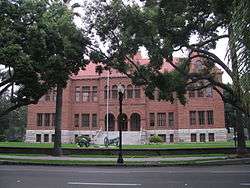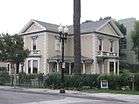Downtown Santa Ana Historic Districts
|
Downtown Santa Ana Historic Districts (North, Government/Institutional and South, Retail) | |
 Old Orange County Courthouse | |
 | |
| Location | Roughly bounded by Civic Center Dr., First, Ross, and Spurgeon Sts., Santa Ana, California |
|---|---|
| Coordinates | 33°44′54″N 117°52′5″W / 33.74833°N 117.86806°WCoordinates: 33°44′54″N 117°52′5″W / 33.74833°N 117.86806°W |
| Area | 24.5 acres (9.9 ha) |
| Built | 1877 |
| Architect | multiple |
| Architectural style | Late 19th and 20th Century Revivals, Moderne, Mission/Spanish Revival |
| NRHP reference # | 84000438[1] |
| Added to NRHP | December 19, 1984 |
The Downtown Santa Ana Historic Districts is a combination of local historic districts that have been listed as one entry in the National Register of Historic Places since 1984. It is a 24.5-acre (9.9 ha) area. Also known as the Historic Downtown District in Santa Ana, it is roughly bounded by Ross to French streets and First to Civic Center streets. The district is characterized by a number of buildings in the Art Deco style as well as two old movie houses (The West End and the Fox West Coast). Orange County's first Courthouse, now a museum, is also located on Civic Center and Broadway streets. The Dr. Willella Howe-Waffle House and Medical Museum is also in this area and it is now home to the Santa Ana Historical Preservation Society. The County's first theater, Walker's Theater, was built in 1909 on Main & Second streets adjacent to the old City Hall. Today, the Main Street Studio Lofts now stand where the county's first movie house used to be.
National historic district
Contributing properties
The National Register of Historic Places states that the Santa Ana Historical Downtown District is 'roughly bounded' by Civic Center Drive, 1st Street, Ross, & Spurgeon, however, the historic district nomination form does provide a list of contributing properties and detailed maps of the included area. The district consists of two section with a total of 99 buildings that remain from the commercial code of Santa Ana. The buildings date from the late 1870s to the post earthquake reconstructions of 1934. The district is divided into two parts, north and south, due to a break in the historic integrity.[2]
History
The City of Santa Ana was established in 1869 by William Spurgeon on 74.27 acres (300,600 m2) of land purchased from the old Spanish land grant, Rancho Santiago de Santa Ana. The County of Orange was formed in 1889 by William Spurgeon and James McFadden. Santa Ana was chosen as the county seat of government because of its larger growth as a town compared to surrounding towns such as Orange. The Old Orange County Courthouse was built in 1901 and thus the town blossomed into the county's main economic and political center. The surrounding old town buildings then became what is now Santa Ana's Historical Downtown.
Downtown Santa Ana Today
The Historical Downtown can be characterized by a northern Institutional region bounded by artist colonies, 'La Cuatro' retail, as well as restaurants filling in the adjacent sections.
The Institutional area contains the Santa Ana Civic Center, which includes the Old Orange County Courthouse, the Ronald Reagan Federal Building, the United States Courthouse, the California Court of Appeal, and various city, county, state and federal facilities.
The restaurant and retail sections have three distinct business districts: the Artists Village and Calle Cuatro Marketplace (West End and East End).
In recent years, efforts have been made to renovate the retail section by continuing to attract new businesses, entrepreneurs, and a creative culture.
The major sections/corridors within the Downtown Santa Ana Historic Districts include:
- The Artists Village
- Historic 4th Street
- Calle Cuatro Marketplace
- East End
- The West End
- The Civic Center/Courthouse District
Artists Village
The Artists Village is an area composed of art galleries, studios, creative offices, design workshops, and several restaurants. It is located on Second Street at Broadway, in the center of Historic Downtown Santa Ana. The village extends from First Street to Fourth Street, Bush Street to Birch, and surrounding the Second Street Mall between Broadway and Sycamore Street.[3]
Originally proposed in the mid-1980s, the village was meant to revitalize one of Orange County's oldest cities and bring back part of a once-thriving downtown with dozens of historical buildings, most vacant for years.
In collaboration between the Santa Ana City Council, the community activist Don Cribb, and Cal State Fullerton’s Gallery Director Mike McGee, a plan for the Grand Central Art Center was conceived in 1994. A designated ten-square block would become the Artists Village. The subsequent success of the Artists Village has helped spawn a cultural and economic renewal.
In the early 2000s, several live-work loft developments came to the downtown including Main Street Studio Lofts, East Village, as well as Artists Village lofts. These artist-centric developments allowed homeowners to experience downtown living while providing them an opportunity to help the flourishing art movement continue to move forward.
Today, the Artists Village is the home to various restaurants, shops, artist galleries, as well as art institutions, including Cal State Fullerton Grand Central Art Center and the Orange County Center for Contemporary Art.
Historic 4th Street "La Calle Cuatro", West End and East End
The historic corridor 4th Street, also known as La Calle Cuatro, is located East to West from Grand Ave to Sasscer Park in Downtown Santa Ana. It is lined with a variety of boutiques, restaurants, as well as various other retail shops and services that cater to a wide audience and multiple demographics.
The centerpiece of Santa Ana's Historic Downtown Corridor is the Historic 4th Street (currently known as Calle Cuatro Marketplace). The West End sits across from the Ronald Reagan Building and consists of lounge cafes, breakfast, lunch and dinner dining, coffee shops, jewelers, craft breweries, bars, retail, barber shops, and movie and concert theaters. The middle of Calle Cuatro contains businesses and stores in travel, insurance, clothing, electronics, sports, shoes, and other needs from baptismal certification to bridal and banking.The East End includes restaurants such as The Playground (started by former Great Food Truck Race winner Chef Jason Quinn) as well as the refurbished Yost Theater. Many retailers and restaurateurs have followed suit and have helped this area compete with neighboring destinations including downtown Anaheim and Costa Mesa. The newest refurbished amenity is The Frida Cinema: a two-screen theater converted to an art-house theater showcasing independent film and film related programming, community-building, and education. Special events at the Frida Cinema include weekly Sunday matinee's, student films, foreign films, film festivals, and cult classics such as Rocky Horror Picture Show. All of Calle Cuatro from West to East is a pedestrian-friendly outdoor mall that markets to the local community, regional shoppers, and tourists.
In February 2015, The 4th Street Market opened, introducing an indoor food market to compliment the expanding food scene. Similar to the Grand Central Market in Downtown Los Angeles or the Boston Public Market, the 4th Street Market includes a variety of tenants including Portola Coffee, Electric City Butcher, as well as host an incubator/accelerator kitchen where up-and-coming food producers can utilize the Market's facilities to prepare, package, and sell their goods. The facility also is partnered with Food Centricity, which offers culinary education and acceleration and consulting services.
The West End (Civic Center and Courthouse District)
The West End (located between Ross Street, Broadway, and West 4th Street) is home to many historic buildings and is situated directly across the Ronald Reagan Federal Building and United States Courthouse.
Over the past years, this section of the downtown has successfully blossomed into a cultural and entertainment hub for Orange County's LGBT population, with notable LGBT-friendly destinations including Theater Out, VLVT (Velvet) Lounge, as well as the West 4th Street corridor playing host to the annual Orange County Pride Festival.
Located less than a quarter mile away on Civic Center Drive is the Santa Ana Civic Center, home to several Institutional City and County buildings including:
- Santa Ana City Hall (Civic Center Plaza)
- Santa Ana Civic Center Plaza (Ross, Civic Center, Santa Ana Blvd, Flower)
- Santa Ana Public Library (Civic Center Dr. & Ross)
- Santa Ana Transit Terminal - OCTA (Santa Ana Blvd & Ross)
- Old Orange County Courthouse (Civic Center, Broadway, Sycamore, Santa Ana Blvd.)
- Orange County Courthouse (Civic Center Plaza)
- Orange County Public Law Library (Civic Center Plaza)
- Ronald Reagan Federal Building and United States Courthouse (4th & Broadway)
- Fourth District Court of Appeals (Civic Center Plaza on the corner of Santa Ana Blvd & Ross)
- Office of the District Attorney (Near the corner of Ross & Civic Center)
- Mexican Consulate (Near Civic Center & Broadway intersection)
Events in Downtown Santa Ana
The prevalence of entrepreneurship, diversity, and a young population (median age of 29.1)[4] have contributed to several weekly, monthly, and annual events. Some of these events include:
- 1st Saturday Downtown Art Walk
- Dia de los Muertos (Day of the Dead [Weekend following Halloween])
- DTSA Farmers' Market (Sunday mornings)
- Fiesta Patrias
- Savor Santa Ana
- OC Pride Festival
- Patchwork Craft Fair
- Santiago Art Walk
- Golden Years Vintage Market
- Boca de Oro Arts & Literature Festival
- Sound Downtown
- The Blading Cup (Every November)
Downtown Santa Ana in the Coming Years
Officials with The City of Santa Ana have stated that in the coming years they will continue to expand its growth in an effort to compete with adjacent cities looking to capture an audience looking to live in a true downtown setting. Some of these goals include:
- Attracting high-end boutique/hotels
- Continuing to convert old office buildings (adaptive reuse) to upscale housing and creative office space
- Converting parking lots and underutilized properties into ground-up residential projects
- Redeveloping the 3rd/Broadway parking structure into a mixed-use (housing or hotel) development
- Implementing a streetcar connecting the Santa Ana Regional Transportation Center (SARTC) to Downtown (approved by OCTA and planned to open 2019)
- One-Broadway Plaza
- Continuing to attract the "Creative Class" as well as more influential players within the technology industry
Images
- Contributing buildings in the historic district
- The Old Santa Ana City Hall, an Art Deco structure

 Minter House
Minter House Old Orange County Courthouse
Old Orange County Courthouse First Presbyterian Church
First Presbyterian Church The Santa Ana Performing Arts and Event Center
The Santa Ana Performing Arts and Event Center Masonic Symbol on The Santa Ana Performing Arts and Event Center
Masonic Symbol on The Santa Ana Performing Arts and Event Center Clock Tower atop W. H. Spurgeon Building (as seen from 4th street, between Broadway and Sycamore Streets)
Clock Tower atop W. H. Spurgeon Building (as seen from 4th street, between Broadway and Sycamore Streets)
References
- ↑ National Park Service (2009-03-13). "National Register Information System". National Register of Historic Places. National Park Service.
- ↑ Harold M. Thomas (April 1984). "National Register of Historic Places Places Inventory - Nomination Form: Downtown Santa Ana Historic Districts (North, Government/Institutional and South, Retail)" (PDF). National Park Service. Retrieved January 20, 2016. Accompanying 93 photos.
- ↑ "Downtown Santa Ana: Orange County's hub for vibrant arts and entertainment". Orange County Register. 2015-03-02. Retrieved 2018-05-15.
- ↑ "Facts and Figures, City of Santa Ana". www.ci.santa-ana.ca.us. Retrieved 2018-05-15.
External links
| Wikimedia Commons has media related to Downtown Santa Ana Historic Districts (North, Government/Institutional and South, Retail). |
- City of Santa Ana
- Santa Ana Public Library
- Santa Ana Historical Preservation Society
- Santa Ana History Room Photograph Collection
- Cinematic Treasures—Closed Movie Theaters, Santa Ana
- National Register of Historic Places